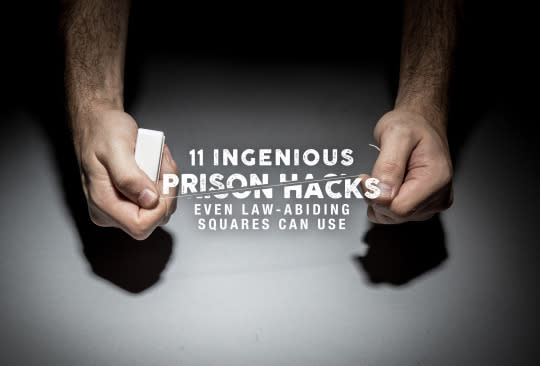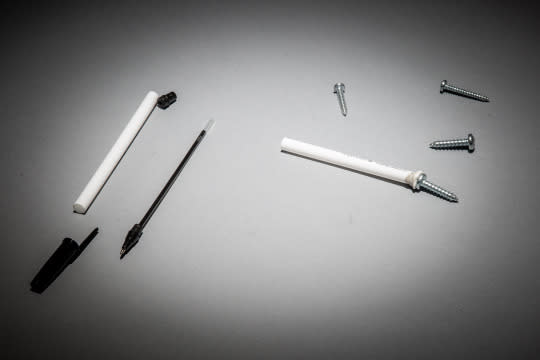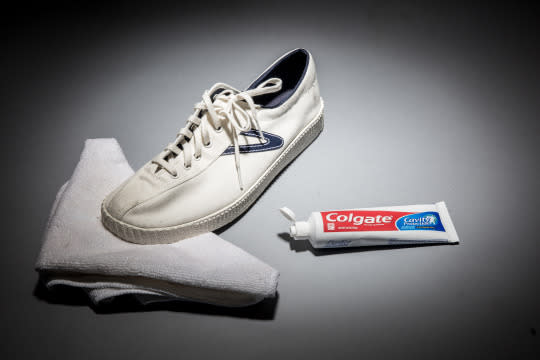11 Ingenious Prison Hacks Even Law-Abiding Squares Can Use
By: Daniel Genis

Credit: Cole Saladino/Thrillist
Hacking computers makes them do your bidding; hacking your life makes it your own. And nowhere is it harder to claim the time you’re allotted than in prison, where I recently did a decade for a couple of amateur robberies I committed as a heroin addict. During my years inside, I learned a few ingenious solutions to everyday problems from my fellow prisoners. Some are unnecessary (hacked typewriters and rigged Walkmans are still obsolete); others are just bad ideas (the guy who tried to whiten his teeth with bleach-soaked toilet paper wound up with snow-white dentures); and others still are both unnecessary and bad ideas (like using a rolled-up magazine to beat someone to death). However, a number of hacks have stayed with me as superbly practical. Here they are.
More: The Fine Art of Cooking in Prison
1. The dental floss hacksaw
This hack is the reason rubber dental loops are sold in many prison commissaries instead of spools of floss. Floss is made of nylon, and it’s strong enough to braid into a ladder, sew up a wound, or stitch together a dummy to take your place during the count. Chefs have a floss hack of their own; a cake cut with dental floss has sharper edges than the mess a knife can leave. You can also use floss as a hacksaw if you add toothpaste for abrasion, but that can turn into a full-time job. MythBusters tested it, and their robot took 300 eight-hour days to cut through a steel bar.

Credit: Cole Saladino/Thrillist
2. The instant screwdriver
Screwdrivers are rare inside, but as long as you smoke, or know someone who does, you have everything you need. Take a plastic pen and remove everything, leaving just the hollow plastic tube. Heat the tip with your lighter for less than a minute and press it into the screw head. Let it cool and harden, assuming the shape you need. Screw.
3. The forever stamp
Stamp collectors call them “philatelic specimens,” but convicts call them money. Packs of Newport cigarettes (“bricks”) are the bills in prison economics – one was worth 10 bucks when I left – but if you buy something worth less than that, you get change in stamps. The rate was 20 “flags” to the “brick” in 2014. But they’re only worth something if they haven’t been cancelled by the post office. Luckily, you can usually un-cancel them. Simply place the stamp face down on the head of a roll-on antiperspirant and wait a day. In 24 hours, the offending ink either wipes off with the swipe of a thumb, or it doesn’t. It works about half the time.
More: 12 Quick and Easy Home Hacks Every Renter Should Do

Credit: Cole Saladino/Thrillist
4. The eco-friendly roach trap
Most older prisons are overrun with vermin. A dropped cookie in prison will introduce you to a swarm of ants immediately; any leftovers on a counter or table will summon roaches. The bugs come up through cracks and under doors; and your table legs are like the mall escalator to the food court. Prisoners don’t have poison to deal with the infestation, but water is available in every tap. So they take plastic jar lids, place them under the legs of their table, and fill them with water. Bugs will do anything for a meal, but they won’t swim. Or they can’t. Which is why you’ll want to empty the lids.
5. The pencil cigarette lighter
Convicts are the last American cohort to get the news that smoking kills, and prisoners have devised many ways to get around the absence of lighters in commissary. Simply connecting the two poles of a battery with a thin wire causes it to heat up enough to light a smoke. (Cool convicts make a loop that torches their coffin nail more evenly.) But since batteries are not really made for this, the “lighter” only works if is chock-full of juice; 30 cigarettes lit and you’re done. If you do have a lighter and it’s out of gas, you can still use it for a light. It’s got flint in it, which prehistoric man struck for sparks for eons. Grind your flint into powder by turning the striker wheel backwards and collect what comes out in dry toilet paper. Now spark the lighter at the grey pile. Eventually your shower of tiny lightning will ignite the flint, which is just enough of a flame to get the paper going.
6. Lightning round: Useful workplace insights inspired by jail
A) The first guy who comes up to make friends with you in a new spot is desperate for a reason. B) Your views or opinions on something can be traded for other information. This happens without your knowledge, but the consequences can be very personal. Unleash your opinions with care. C) The easiest way to be a decent human being is to only say things about someone that you would say to them. D) This only works with amateurs, but liars often break eye contact at the very moment they speak an untruth. E) To beat a lie detector, put a thumbtack in your shoe. Prick yourself when answering every question; you will be deemed a highly emotional and unreliable witness. (You never know.)
More: 31 Things the Internet Can Teach You for Free

Credit: Cole Saladino/Thrillist
7. The magazine Kevlar vest/bank account/fishing rod
Prison is a violent place where anything can be weaponized. I saw a can of black beans swung in a bag break a man’s arm. I also saw a guy retrieve the dented tin and eat the beans. But magazines have the rare capacity to be both offensive (see intro) and defensive tools. I have taped glossy periodicals around my torso to shield my organs from puncture – National Geographic was most effective; the New Yorker skimps on the paper stock and provided limited protection. Magazines are also used to conceal cash; gluing the pages together makes a decent stash. And the pages can be ripped out, rolled into tubes, and formed into a fishing rod, to snag things out of reach. And they say print is dead.
8. The Walkman tattoo gun
In a place designed to stamp out your individuality – uniforms, shaved heads, numbers instead of names – tattoos take on a special significance. Prison authorities can’t erase them, although they meticulously catalogue them and severely punish those caught giving and getting “work.” The most primitive method involves needles wrapped in thread and ink made of soot and shampoo. (More on this below.) It’s painful, low quality, and takes a long time. So some convicts started making tattoo guns out of engines inside computer fans, whirring toys, and cassette players.
Whatever you’re using must run on batteries. A nine-volt battery or a dozen AAs taped together power a typical device, with a paper clip serving as a power switch. Because a tattooing needle must go in and out, rather than turning the way a motor does, builders melt a needle onto a gear of a Walkman motor at a right angle and off-center. The mechanism changes a circular motion into a pecking one, like the needle of a sewing machine. This ingenuity behind this device impressed me far more than the skeletons and swastikas it was so frequently used to inscribe.
(By the way, the cops know the value of a motor, so unless it was your first time ordering a Walkman from the commissary, you could only get one by turning in your old cassette player. And when you did that, the guards in the package room checked to make sure the motor was still in it. The result of these prohibitions was yet another hack: dummy motors.)
9. Chess-piece tattoo ink
Some prisoners can get India ink with specialized hobby permits for artistic endeavors. Some use burned-up newspaper mixed with shampoo, which yields tattoos that turn blue by next Christmas and fade into a blur before presidents change. But by far the best recipe for black ink requires shampoo to make it gooey, a dash of urine for sterilization, and a little arson. Take anything plastic or rubber, like a chess piece or the heel of a boot, set it on fire, and hold a piece of cardboard over the blaze. The stain left is carbon ash. Scrape it off, mix it with shampoo and piss, and you have ink.

Credit: Cole Saladino/Thrillist
10. Toothpaste shoe polish
Sneakers and boots are issued as part of a convict’s uniform. In New York State, the white Converse clones, made in China, are handed out once a year. (When I began my bid, they were dubbed “Patakis” in honor of our governor. Spitzer didn’t last long enough for the appearance of AirEliots, but “Pattersons” and “Cuomos” made it into the parlance.) Wearing these shoes, however, is like being an Untouchable in the Indian caste system; any sneaker from the real world is preferable, even secondhand. And if you have one of these status symbols, you’ll want to hold onto it for a while.
Enter shoe restorers, who hack life back into tired kicks, carefully washing laces, shaving a layer off the soles to reveal a fresh white epidermis, and most important, brushing their teeth. An hour with a toothbrush and paste gives shoes a gleam; the same whitening molecules meant for enamel work on Adidas. When I saw my old Pumas, unmistakable because of their hideous color combination, on a stranger’s feet two prisons after I last wore them, they looked better than they did when they were in my possession.
11. Head luggage
Smuggling is part of a prisoner’s life, but everyone has moments when successfully concealing something determines which way your life goes. Your noggin is readily accessible, easy to monitor, and not the first place people look. Men I knew would hide things in their nostrils, or down their throats, suspended from their molars by a loop of dental floss. But hair was the most interesting. Prisoners who register as Rastafarians can grow dreadlocks. The ones who need a compartment to carry things in sculpt their dreads into one. It may look like a beehive, but the extra structure on top of your head has room for all sorts of things. I’d recommend trying it with a man bun. But then I’d also recommend prison for possession of a man bun. Pick your poison, and happy hacking!
More from Thrillist:
The Secrets of Crazy-Productive People
